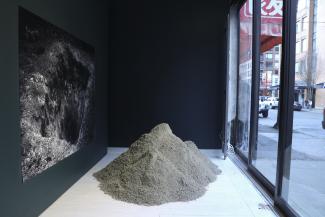During her performance of Warmblood, Vicky Sabourin removes stones from inside a felted horse and enters the cavity of the beast, laying inside with her legs exposed. Investigating the bond between rider and horse, Sabourin repeats the cowboy’s evisceration of his trusted mare and his subsequent renewal. This brutal act is a recurring narrative—from wilderness expeditions in colonial history to fairytales to imperialist sci-fi—where protagonists facing exposure and predation resort to this and other extreme survival strategies. How, Sabourin imagines, can a rider sacrifice his horse to save his own life?
Sabourin’s performance, and its vestige as installation, meditates on the lore of the cowboy, imprinted in our collective imagination through cinema, television, print media, and literature. I am not a rider, but I feel a phenomenological connection to Warmblood resulting from a recurring dream in which I am a horse. I’ve imagined an equine musculature propelling my body at full speed. I can imagine my body inside this body, because I’ve experienced myself as this body. I feel the weight of my torso as I wake from a dream state, mirrored by the stones the artist removes from the horse’s cavity, the suffocating space into which she retreats. I embody this dream experience only through my own personal mythology, deeply rooted in the imagery of my settler culture.
Sabourin’s work delves into multiple layers of her own identity, drawing from fairy tales, mythology, and her own family history. Trained in photography, she considers herself an image maker, combining installation and performance through tableau vivant, diorama, and video. Most components of her installations are produced by her hand—carved, sculpted, or felted. Others originate from her personal collection of objects gathered from nature or antique sales. Conflating fact and fiction, she builds her narratives from fantasy and traumatic events from her history. Her tableaux are familiar and sometimes perverse, using seduction to elicit myriad emotional responses—desire and repulsion, fear and wonder.
In her 1980 essay, "Powers of Horror: An Essay on Abjection" Julia Kristeva’s expands the definition of abject to mean the distinctly human reaction to the transgression of boundary resulting in the loss of distinction between subject (self) and other (object). The skim on a bowl of milk is more repulsive because we imagine consuming it. A corpse reminds us of the materiality of our own body. Just touching the edge of abjection, Warmblood uses the evisceration narrative to explore the intensely intimate relationship between rider and horse. By choosing to craft the horse by hand instead of using a skin, Sabourin ensures that the creature and her performative gesture remain symbolic. Felted, the horse is both body and blanket.
Transgressing the boundary of the horse’s cavity, Sabourin surrenders to the vulnerability of her position. Legs exposed, I imagine she feels the gaze of the audience, and hears their the muffled conversations through the suffocating body. Like a rider in the wilderness at risk of exposure, she is neither completely separate to nor part of her context. She and the horse are the same, and they are powerless. Yet through her act of breathing within this hollow body, both are reanimated. Who in this scenario is the noble creature—the horse, the rider, or the hybrid?
Accompanying her exhibition, Sabourin’s newest work, Becoming Invisible, is on view in Access Gallery’s PLOT space—a site for exchange and experimentation. Taking falconry as its starting point, this work-in-progress is part of a multi-chapter project that includes performance, video, ceramics, and photography.
While Warmblood relies on Sabourin’s visibility as subject, in Becoming Invisible, she addresses her own disappearance. Equine control relies on the rider’s strength and direction, whereas when the falconer trains the bird of prey, they attempt to become as invisible to the bird as possible, allowing it to get accustomed to their presence. The human then slowly reveals themself to the bird on its arm, through breath, sound, and gesture. Each time the falcon flies, the falconer faces the risk that his prize may not return. While a rider and horse may act as one body, a falcon will never be tamed. Is this bending of the instincts of a wild animal to one’s purpose the perverse pursuit of a Western desire to return to wilderness, or simply an attempt to control it?
Falconry is ingrained in tradition and wealth, stemming from the control of hunting game by landowners. In settler narratives, there is a glorification of the cowboy and frontier, in rejection of these wealthy landowners. Yet both the aristocrat and the cowboy exemplify Western man’s sense of his right to the wild—one through the divine right of kings, the other through Manifest Destiny—each reliant on his subjugation of his environment and its inhabitants, including his fellow humans. Warmblood considers the potency of the horse as a symbolic motif, emblematic of the power dynamic man attempts to exert upon the world. The rider can bear to sacrifice the horse to save his life, because to him, the horse exists for him.
Katie Belcher





